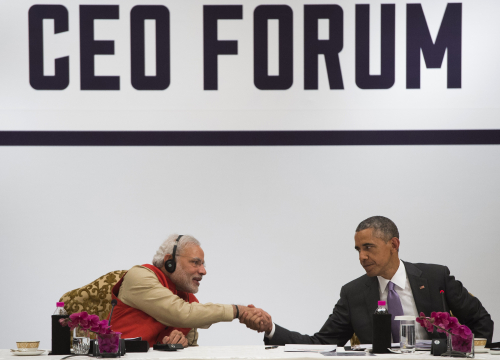 |
|
RESPECT: Indian Prime Minister Narendra Modi and U.S. President Barack Obama shake hands during the India-U.S. Business Summit in New Delhi on January 26 (CFP) |
 U.S. President Barack Obama paid a three-day visit to India at the end of January and attended the country's Republic Day celebrations, becoming the first U.S. state leader to attend the Indian national event. In the meantime, as Indian media outlets have pointed out, Obama is also the first incumbent U.S. president to have visited India twice in one term. Intense media coverage of U.S.-Indian relations was widely visible throughout the country in the weeks prior to Obama's arrival in New Delhi. Almost every detail of Obama's trip made headlines, clearly illustrating the importance India attached to the diplomatic event. Indian Prime Minister Narendra Modi greeted Obama personally at the Air Force Station Palam, prompting Obama to comment later that the United States could be India's "best partner."
U.S. President Barack Obama paid a three-day visit to India at the end of January and attended the country's Republic Day celebrations, becoming the first U.S. state leader to attend the Indian national event. In the meantime, as Indian media outlets have pointed out, Obama is also the first incumbent U.S. president to have visited India twice in one term. Intense media coverage of U.S.-Indian relations was widely visible throughout the country in the weeks prior to Obama's arrival in New Delhi. Almost every detail of Obama's trip made headlines, clearly illustrating the importance India attached to the diplomatic event. Indian Prime Minister Narendra Modi greeted Obama personally at the Air Force Station Palam, prompting Obama to comment later that the United States could be India's "best partner."
Warming relations
A BBC commentary prior to Obama's visit said that guests that are invited to attend Republic Day are traditionally those who will not arouse domestic controversy, and whose home countries enjoy close strategic relations with India. "This is the first time that a U.S. head of state will be given this honor by India and reflects, more than anything else, the degree of comfort that New Delhi has in its relations with Washington," the commentary noted.
In the 70 years since India's independence, the country's relationship with the United States has undergone many twists and turns. During the Cold War era, South Asia was nearly divided into two rival parts--Pakistan and the United States on one side, and India and Russia on the other. With the end of the Cold War,
U.S.-Indian relations began to thaw out. Entering the new century, the relations of the two countries warmed up rapidly as the United States sought to woo India. In 2000, the then U.S. President Bill Clinton paid the first state visit to India by a sitting U.S. head of state in 22 years. After George W. Bush took office, U.S.-Indian relations were further strengthened. In 2005, the then U.S. Secretary of State Condoleezza Rice made India the first stop of her Asian tour, where she stated publicly that "the United States will help India become a global power in the 21st century."
Shortly after President Obama assumed office for his first term in 2009, the erstwhile Indian Prime Minister Manmohan Singh visited Washington. Obama said at a press conference that U.S.-Indian relations would play a decisive role in the 21st century. He also affirmed to Singh that the United States and India would jointly prevent nuclear weapons proliferation, marking the first time that the United States publicly recognized India as a nuclear-weapon state. However, U.S.-Indian bilateral relations were shaken in 2013 when an Indian diplomat named Devyani Khobragade was arrested on charges of visa fraud and underpaying her maid in accordance with U.S. law, which was met with an Indian retaliation. In addition, differences over issues of climate change, civilian nuclear agreements and trade facilitation negotiations between the two sides have also emerged.
Since Modi took power in 2014, the Indian Government has put greater emphasis on promoting "economic diplomacy." Mending bilateral relations has become a common aspiration for both the United States and India. Following Modi's visit to the United States in September 2014, Obama attended the ceremony of the Indian Republic Day parade. In Obama's latest New Delhi trip, the two countries also released several joint statements including the Joint Strategic Vision for the Asia-Pacific and Indian Ocean Region. Meanwhile, the two sides have made great progress in civilian nuclear cooperation, defense cooperation, trade and economic cooperation and climate change issues. India will set up a fund of 15 billion rupees ($240 million) to help U.S. nuclear reactor builders avoid risks associated with the Indian Nuclear Liability Act. The United States will provide India with $4 billion of investment and loans, among which a $2-billion investment will go to renewable energy projects, a $1-billion loan will be used to spur the development of small and medium enterprises in India, while the remaining $1 billion will boost U.S. exports to the Indian market.
Modi's American dream
The leaders of the United States and India have expressed a desire to take a practical approach to strengthening bilateral ties. For India, improving relations with the world's biggest power is a matter of obvious importance. In the meantime, the advanced technology and wealth of the United States also have huge appeal for India.
